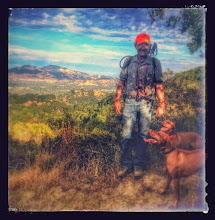
The below section is from Cesar Millan. This gave me a idea of how walking Chloe and Bailey on leash for long distances helps them.
In his first book he talked about how a homeless person's dog is so well behaved.
So at least three times a week we walk on leash for one or two hours. At least once a week we walk downtown Walnut Creek so they are comfortable with traffic and people.
I figure Chloe and I have logged 600 miles in the last 22 months of leash-time walking. Bailey has about half that. They both must stay on my left and just behind or to my side. Bailey, being the young gentledog he is, stays to the outside to protect his older sister.
"The single most powerful tool we have for bonding with our dogs is the walk. Walking is a primal exercise that awakens all of her pack instincts. No amount of toys or treats will make her happier than a brisk, hourly walk by your side. Yet the walk is one area where dog owners seem to have the most problems. Most people have the dog out in front, pulling them forward. I’ve asked the reason for this and I usually get, “She loves her freedom.” Freedom?
A dog is a pack animal and what she really wants from the walk is leadership and structure. To me, the best role models for great dog walking technique are the homeless and the service dog-using handicapped! Why? They seem to better understand the concept of canine pack leadership. The leader is always in front during the walk. And for many homeless, their dogs often aren’t even on a leash – they choose to stay behind or beside their owners.
Of course a dog wants to sniff the ground and pee on a tree during the walk, but it is important that we as pack leaders understand that we should be making the “when and where” decisions for them. Following our rules gives the dog confidence because she’s working for every privilege she gets." - Cesar Millan








1 comment:
Hey that's interesting but I think you really have to think about where the Vizslas are coming from when talking about walking on the lead or heel. They are Pointers and in the field always (working) in the front of their humans or walking ahead.
Observe once exactly how the dog runs and you maybe see the solution: The tempo which his two legged friend gives is simply to slow for the pace step of the dog. Most hunting dogs are gallopers. To put back longer distances in a comfortable way for their anatomy , they use the trot. They slow down their pace or stop-and-go ( except in the house ) only when they approach game , birds or scent , because here it makes sense. It's not an aversion to the lead itself nor the need to be close to his leader , but simply the inappropriate speed for them.
If my dog trots without any hurry, I must already run quite swiftly. If he goes in a pace very natural to him, I must walk in a big hurry. My other dog has never learnt to walk heel in a dawdling way ; his movements were always absolutely unharmonious and the hind legs seemed to try constantly to overtake the forelegs. But when the same dog runs next to me on the lead while I'm jogging, it's an aesthetic pleasure to look at him - elegantly and smooth movements in his pace and just perfectly and easily besides me.
With dogs under approx. 50 cm height all that is no subject, but for breeds about 60 cm and more it can become really agonizing to have adapt itself to our snail tempo. Try to permit your heel walking dog a tolerable pace.
Pointers are trotters and gallopers - it's in their nature!!
Post a Comment